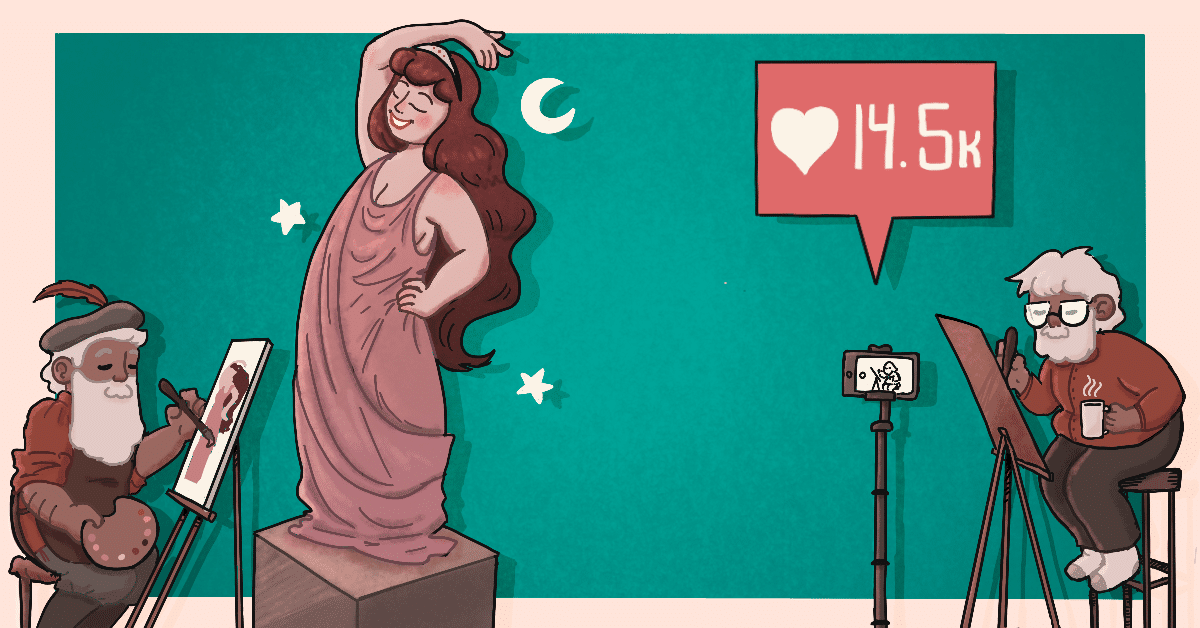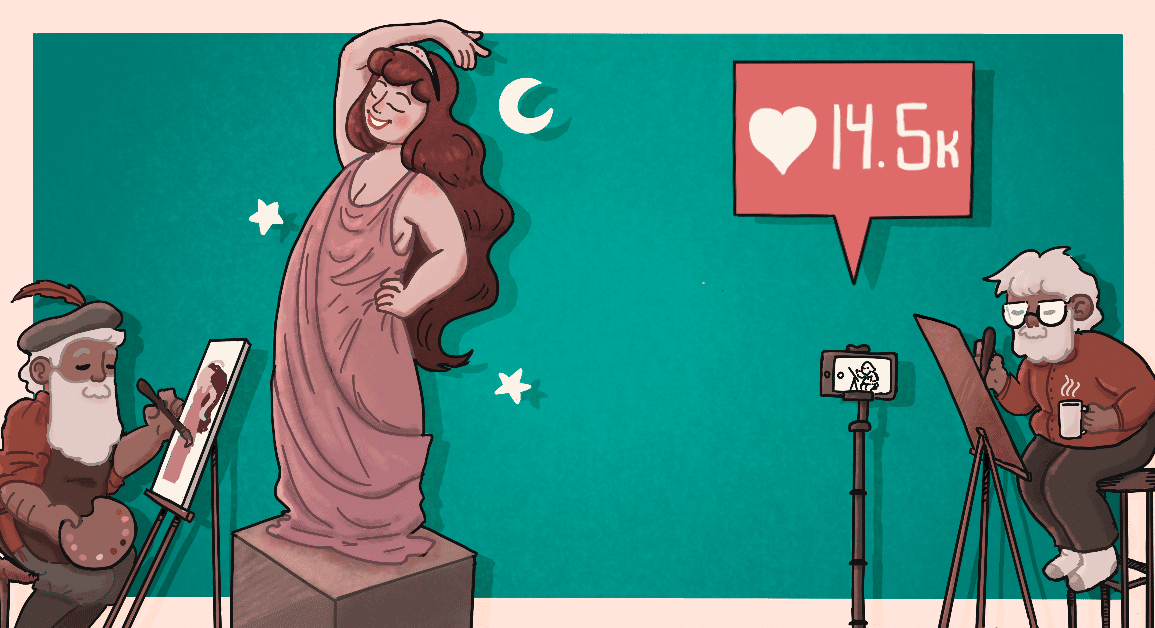
The art world has always been a nebulous thing. But as artists gravitate more and more to social media to establish themselves professionally, sell their work, and connect with other artists, its boundaries have shifted. How artists present themselves, and to whom they cater, have become ever more pressing questions as the social media page takes center stage.
Although hard to pin down, the art market has its stereotypes. Wealthy gallerists, connected artists, and obscurantist critics dominate the imagination. But this image has little in common with the for-you page, where artists are enticed to post by the low barrier of entry and potential for high returns on virality.
Here, the art market becomes more tangible to people outside of it. People who would otherwise struggle to find art they like, and even more to find art they’d buy. But is it so simple, that social media has made accessible what was previously not? What are the implications of this shift towards social media? And if that’s something you want to take part in, how do you even start?
Actually selling your art
There’s really one key principle to selling your art online: engagement. Without engagement you have nothing, and every strategy is just an elaboration of that. You need eyes on your work, but more importantly, you need people sharing your work. That doesn’t happen unless you know how to capture people’s attention and keep it.
The first step is to know your platform. Instagram and TikTok, with their emphasis on images and videos, dominate. The art itself takes up the whole screen, and that means that first impressions are big. Is your work colorful and maximal, grey and minimal, or anywhere in between? That’s what they’ll expect to see, so be intentional with your posts and give people the right idea about your art.
Think of this as your hook. After that, people can take a little more time to peruse your page and get a sense of what they’ll get out of following you. If you post frequently, your page will continue showing up in their feed, maintaining their interest in your work, and increasing engagement!
You’ll also want to engage with other artists. Let the algorithm see what kind of things you like and it’ll bring you together. Leaving comments on others’ work and even reaching out in the DMs is a great way to not only promote your work but to make friends and exchange ideas, as well.
But you’ll need more ingenuity than that if you want to stand out. There’s so much artwork posted to Instagram every day, that if you want people to notice your art, you need to capture their interest in you as an artist, as well. That’s because it all comes down to one thing in an engagement economy: your brand.
Engagement, engagement, engagement
There’s no surefire way to brand yourself. Everyone and their work is different. But people like familiarity, and if they can easily understand you and your niche, they’ll want to follow you further. Who are you, and why are you making this work? Answering these simple questions gives people an immediate ‘in’ to understanding your vision, making it accessible, maybe even relatable.
Another way to look at this is that you’re crafting a story. In fact, you’re crafting your story! It’s hard to contemplate a work of art over time on a social media feed, where so many other things grab your attention. But by giving your audience a character to connect to, you tell them who and what your art is about.
One of the ways creators achieve this is by posting behind-the-scenes content. The way you set up your studio, care for your tools, or even go on a coffee run are all little things that create a bigger picture of who you are and what you love to do. This is about giving people a window into the person behind the work, a narrative that you and your pieces illustrate.
But wait… do we want this?
But let’s pause here before we get too enthusiastic. If we want to celebrate the democratizing nature of social media, in which artists don’t need a gallery deal to connect or get attention, shouldn’t we also care about the kind of attention online artists get?
Engagement is great, but we shouldn’t ignore what chasing it requires: catering to an algorithm. One that is not concerned with supporting the arts or aesthetic appreciation. As many advantages as there are to bringing your artwork to social media, the end result is a feed that sates its audience more than it challenges. Artworks are reduced here to tokens, fitting into pre-established narratives, attitudes, and ‘cores‘, but without a chance to advocate for themselves.
This is not just abstract musing; this arrangement has had a tangible effect on what kind of art gets promoted and what people expect to get out of the art they consume (starting with art being “consumable” in the first place). To understand this better, let’s look at the recent spate of social media artists notorious for ripping off the late neo-expressionist, Jean-Michel Basquiat.
Basquiat clones
Basquiat’s style was heavily informed by his experience as a Black man in America and was steeped in, among other things, the NYC graffiti culture of the 80s, a major forum for Black and Latino artists in the city. The Basquiat Clones, who are predominantly white, make artwork completely disambiguated from that context.
Their work comes after Basquiat’s fame and success, in which his imagery was already proven to be powerful, compelling, and controversial. But without the intentions Basquiat brought to his own work, their art just appeals to some vague notion of “cool,” reifying the actual social dynamics behind the paintings into flashy and consumable images fit for social media.
This degradation is not lost on the audience. Go to the comment section of any of these artists’ “art reveals”. You’ll see scores of people accusing them of cultural appropriation and plagiarism. Then again, you’ll also see people defending the ‘clones’ right to self expression. They say all art is good so long as people enjoy it. But here’s the problem: whether you think it’s good or bad art, by commenting, you are engaging. In an engagement economy, that’s good.
These clones purposefully lean into the worst tendencies of intellectual laziness, specifically to piss people off. And this negative engagement rewards them! Rather than disqualifying them, it launches their work to the top of your For-You feed, getting them enough buyer attention to sell their pieces, some of which are priced in the thousands. And now, artists adding to the net creativity of their community have to share space with the ‘clones,’ seeing more unique works get passed over for these tired copies.
MOCO art show
But these tendencies are not relegated to social media. Seeing what virality can do for ones popularity and ticket sales, some galleries have started to emulate these strategies to bring more people to the door.
The Museum of Contemporary Art, or MOCO, has enjoyed a fair amount of attention this way. In 2017 it opened the Van Gogh Exhibition: The Immersive Experience, a touring art show that promised to drop attendants directly into the paintings of the famed Dutch artists. The exhibit seems designed for instagram. The walls host drifting projections , works by Van Gogh, and the room is furnished with pieces of furniture meant to mimic those within the frame.
But by turning Van Gogh into an experience, he’s also turned into a brand. The implication is that, by experiencing his art as an immersive story, one can become closer to it and get more out of it. The exhibit doesn’t just look good on Instagram, it appeals to the same logic that Instagram promotes and makes accounts popular online.
As some critics have pointed out, these exhibits undermine art appreciation more than they make it accessible. Judgment, curiosity, and reflection that would once come from the audience is now deferred to the curators and influencers who design and promote these exhibits. They decide what the “story” behind the work is, much the same way as one would create a narrative to brand their own art account. Instead of curating what pieces are on display, MOCO curates how their attendants experience the pieces, as well.
The critics on the ‘gram
The cloistering of the art world has started to unravel. Infamous art critic Jerry Saltz has released a list of his favorite, 78 indispensable art accounts on Instagram. He covers bakers, major galleries, meme accounts, and outside art sellers, all active together on instagram. Social media is speaking and institutional art is listening.
It would be naïve to say this has made art more democratic. What once promised to make creation, curation, appreciation, and sale equally accessible to all has proven much thornier. Instead, artists are brought to compete amongst a new set of standards, egged on by a winner-takes-all attention economy.
But it would also be naïve to stubbornly refuse this world. Artists need a venue to work, and will naturally take what’s convenient. That means that artists and critics alike will need to contend with, not dismiss, the logic of social media virality. A logic that has transformed the art world, from communities of emerging artists to legacies already part of the canon.
But “contend with” does not mean affirm. How the new generation of artists will engage with this environment is not yet fully clear, although we’ve seen some general trends. In the interim, what we can ask of ourselves is to always remain sharp. To be aware of where our attention is coming from and going, as much as it may flatter us.
This post was originally published on this site be sure to check out more of their content






